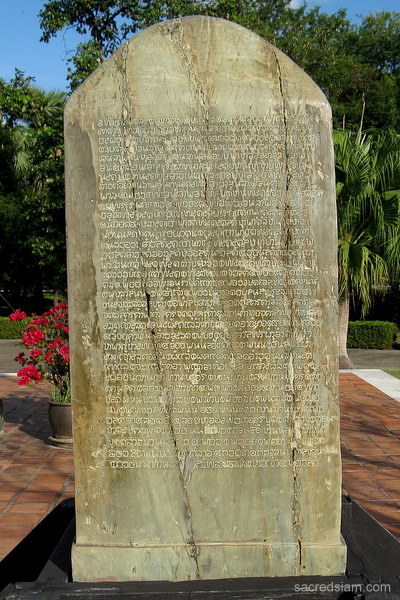| c252 BC | | Buddhism
first brought to Suvannabhumi ("Golden Land" - probably centred around
today's Nakhon Pathom area) by Indian King Asoka's missionaries |
| c550 |
|
Dvaravati civilization of Buddhist ethnic Mon people in
central and northeastern Thailand until the 9th century |
| c1000 | | Ethnic Tai peoples moving down from
southern China; Angkorean empire in control in 11th and 12th centuries,
bringing Brahmanism, Mahayana Buddhism, Sanskrit words and the
Khmer-based royal vocabulary still in use today |
| 1238 |
|
Ethnic Tai Sukhothai kingdom established by King Sri Indraditya |
| 1259 | | King Mangrai first ruler of ethnic Tai kingdom of Lanna |
| 1279 |
|
Accession of King Ramkhamhaeng of Sukhothai |
| 1292 | | Ramkhamhaeng's inscription describing his kingdom |
| 1345 | | Compilation of the influential Buddhist text Triphum Phra Ruang (Three Worlds Cosmography) by King Lithai of Sukhothai |
| 1351 |
|
Legendary foundation of Ayutthaya |
| 1569 |
|
First fall of Ayutthaya to the Burmese |
| 1656 |
|
Accession of King Narai |
| 1688 |
|
Palace
coup against King Narai over the influence of Greek adventurer
Constantine Phaulkon and other foreigners; Phaulkon executed |
| 1767 |
|
Second fall of Ayutthaya |
| 1768 |
|
King Taksin defeats the Burmese and establishes new
Siamese capital at Thonburi |
| 1782 |
|
New capital established at Bangkok, accession of King
Yotfa, Rama I |
| 1822 |
|
First trade treaty with Britain |
| 1851 |
|
Accession of King Mongkut, Rama IV |
| 1855 |
|
Bowring Treaty |
| 1863 |
|
French protectorate of Cambodia |
| 1868 |
|
Accession of King Chulalongkorn, Rama V |
| 1872 |
|
Chulalongkorn's visit to India |
| 1874 |
|
Front Palace Incident; Anglo-Siam Treaty over Chiang
Mai; edict abolishing slavery |
| 1890 |
|
Establishment of Privy Purse Bureau |
| 1892 |
|
Formation of ministerial council |
| 1893 |
|
French gunboats threaten Bangkok (Paknam Incident);
foundation of Ministry of Interior |
| 1897 |
|
Chulalongkorn's first visit to Europe |
| 1901 |
|
Isan Holy Men's rebellion |
| 1902 |
|
Phrae revolt; southern states revolt; Sangha Act |
| 1904 | | Siam Society founded |
| 1905 |
|
Conscription edict |
| 1908 |
|
Sun Yat Sen visit to Bangkok |
| 1909 |
|
Anglo-Siamese Treaty finalizes Siam's boundaries |
| 1910 |
|
Accession of King Vajiravudh, Rama VI; Chinese strike
in Bangkok |
| 1912 |
|
Plot uncovered in military |
| 1913 |
|
Nationality Act; Surname Act |
| 1916 |
|
Foundation of Chulalongkorn University |
| 1917 |
|
Siamese forces to fight on Allied side in World War
1 in Europe |
| 1925 |
|
Accession of King Prajadhipok, Rama VII |
| 1927 |
|
People's Party founded in Paris |
| 1928 |
|
Boycott of Japanese goods |
| 1930 |
|
Ho Chi Minh forms Communist Party of Siam |
| 1932 |
|
Revolution results in change from absolute to
constitutional monarchy |
| 1933 |
|
Boworadet Revolt |
| 1934 |
|
Foundation of Thammasat University; Phibun Songkram
becomes minister of defence and army chief |
| 1935 |
|
Abdication of King Prajadhipok |
| 1937 |
|
Second boycott of Japanese imports |
| 1938 |
|
Phibun becomes prime minister |
| 1939 |
|
Siam renamed as Thailand |
| 1941 |
|
Japanese
army enters Thailand; Thailand declares war on Allies; battle with
French in which 59 Thai troops killed; Victory Monument erected |
| 1942 |
|
Phibun's Sangha Act; Communist Party of Thailand
refounded |
| 1944 |
|
Seri Thai resistance network established; Phibun ousted
as prime minister |
| 1945 |
|
Seni Pramoj returns from the US to conduct peace
negotiations |
| 1946 |
|
Pridi Banomyong's constitution; death of King Ananda
Mahidol, Rama VIII; accession of King Bhumibol Adulyadej, Rama IX |
|
|
|
|
|
|
|
|
|
|
|
|
|
|
|
|
|
|
|
|
|
|
|
|
|
|
|
|
|
|
|
|
|
|
|
|
|
|
|
|
|
|
|
|
|
|
|
|
|
|
|
|
|
|
|
|
|
|
|
|


